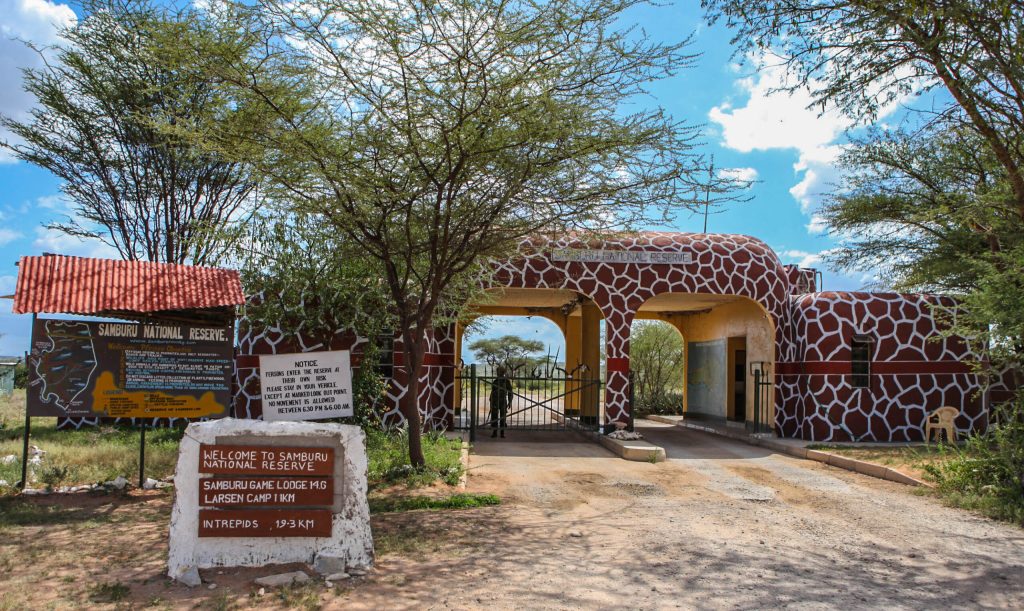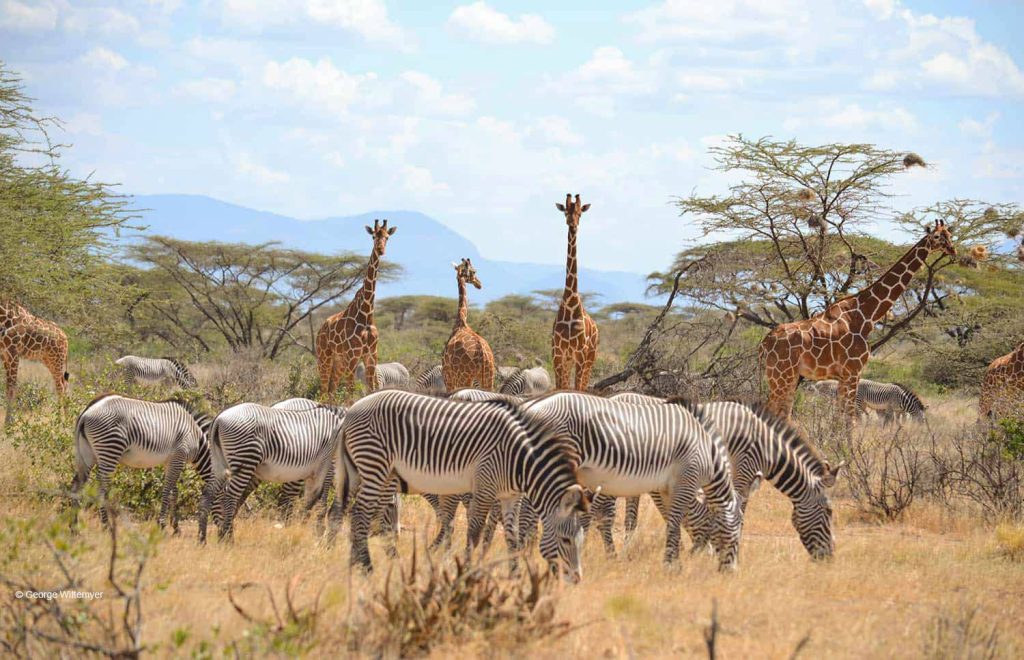Latest Samburu National Reserve Park Fees 2025
Samburu National Reserve Park fees: Nestled in the rugged heart of northern Kenya, Samburu National Reserve stands as a beacon of untamed wilderness and cultural vibrancy.
Spanning 165 square kilometers along the life-giving Ewaso Ng’iro River, this semi-arid haven is more than just a safari destination—it’s a portal to an ancient ecosystem where rare wildlife roams free and the resilient Samburu people preserve traditions that echo through millennia.
As 2025 unfolds, with its promise of enhanced conservation efforts and sustainable tourism, understanding the park’s entry fees and operational nuances is essential for any traveler.
This guide delves into the intricacies of Samburu’s fees, weaving in practical advice, wildlife wonders, and cultural insights to equip you for an unforgettable adventure.
Whether you’re a seasoned safari-goer or a first-time explorer, Samburu offers raw, authentic experiences that linger long after the dust settles.

The Allure of Samburu: Why Visit in 2025?
Samburu’s magnetic pull lies in its uniqueness. Unlike the crowded plains of the Masai Mara, this reserve delivers an intimate encounter with nature’s oddities.
Established in 1962 as a game reserve, it forms part of a larger ecosystem that includes the adjacent Buffalo Springs and Shaba National Reserves, creating a seamless corridor for wildlife migration.
The landscape is a dramatic tapestry: fiery red sands punctuated by thorny acacias, volcanic hills like Mount Ololokwe looming in the distance, and the serpentine Ewaso Ng’iro River carving through it all, sustaining life in an otherwise arid expanse.
What sets Samburu apart is its roster of endemic species, affectionately dubbed the “Samburu Special Five”: the elegant reticulated giraffe with its mosaic-like coat, the long-necked gerenuk that browses on tiptoes like a living ballerina, the endangered Grevy’s zebra with its narrow stripes, the speedy Somali ostrich, and the graceful Beisa oryx.
But the reserve’s biodiversity doesn’t stop there. Home to nearly 900 elephants—whose thunderous herds shape the terrain—Samburu teems with predators too. Lions, leopards (one of Kenya’s prime spots for sightings), cheetahs, and elusive wild dogs prowl the savannah.
Over 450 bird species grace the skies, from the vibrant golden weaver to migratory raptors, making it a birdwatcher’s paradise.
In 2025, Samburu’s appeal is amplified by ongoing conservation initiatives. Community-led projects, like the Reteti Elephant Sanctuary in the neighboring Namunyak Conservancy, highlight human-wildlife coexistence, allowing visitors to witness orphaned elephants being rehabilitated by local Samburu warriors.
Climate resilience efforts, funded partly by park fees, ensure the reserve remains a year-round gem, even as global weather patterns shift.
For cultural enthusiasts, interactions with the Samburu people—fierce pastoralists adorned in red shukas and intricate beadwork—offer profound insights into rites of passage, livestock herding, and oral histories passed down through generations.
Travelers in 2025 will find Samburu more accessible than ever, with upgraded airstrips and eco-friendly lodges emphasizing low-impact tourism.
Yet, with rising global interest in sustainable safaris, advance planning is key. Fees, in particular, reflect a tiered system designed to balance accessibility for locals with revenue for conservation, a model that’s evolved under the Kenya Wildlife Service (KWS) and county management.
Samburu National Reserve Park Fees: What You’ll Pay and Why
Managed by the Samburu County Government rather than solely by KWS, Samburu’s fees are structured to incentivize regional tourism while funding anti-poaching patrols, habitat restoration, and community benefits.
Rates are calculated per 24 hours, starting from your entry time, and apply uniformly across the reserve’s gates. Unlike KWS parks, which saw a proposed fee hike in mid-2025 drafts, Samburu’s structure remains stable for the year, with no seasonal variations—making budgeting straightforward.
The fee categories hinge on residency status, a policy rooted in East African Community (EAC) agreements to promote intra-regional travel.
Kenyan citizens and EAC nationals (from Uganda, Tanzania, Rwanda, Burundi) qualify for the lowest tier with proof like a national ID or passport.
Residents—anyone with valid Kenyan work permits or long-term visas—get a middle rate. Non-residents, including international tourists, pay the premium, which supports broader conservation.
Children under 3 enter free, while those 3-12 (or students up to 23 on organized trips) receive discounts, provided documentation is presented two weeks in advance for student waivers.
Additional costs layer on for vehicles and camping, ensuring self-drive adventurers and overnighters contribute fairly. Vehicle fees are per entry, based on seating capacity, and promote registered safari outfits over private cars.
Camping, a highlight for immersive experiences, incurs per-person-per-night charges plus a one-time reservation fee.
To illustrate, here’s a breakdown of the 2025 fees:
|
Category |
Adult Fee (per 24 hours) |
Child/Student Fee (per 24 hours) |
Notes |
|
Kenyan/EAC Citizens |
KES 500 |
KES 250 |
Valid ID/passport required; free for under 3s. |
|
Residents (Kenya-based) |
KES 1,000 |
KES 500 |
Proof of residence (work permit/visa) needed. |
|
Non-Residents |
USD 70 |
USD 40 |
Standard international rate; payable in USD or KES equivalent. |
|
Vehicle Entry (Self-Drive) |
KES 400 (<6 seats) / KES 1,000 (6-12 seats) / KES 2,000 (13+ seats) |
N/A |
Per vehicle, daily; 4×4 recommended for tracks. |
|
Camping (Public Sites) |
KES 500 (Adult) / KES 200 (Child) per night |
N/A |
Plus KES 10,000 weekly reservation; private sites extra. Hire 2 rangers for security (KES 1,000/day). |
These rates, current as of September 2025, are subject to spot checks at gates like Archer’s (the busiest) or West Gate. Payments accept cash (USD or KES), cards (Visa/Mastercard), or M-Pesa, but carry exact change for smaller fees to avoid hassles.
For multi-day stays, tickets are stamped and valid sequentially—overstay, and you’ll pay extra. Pro tip: Bundled safari packages from operators often include fees, saving 10-15% on admin.
Beyond entry, expect sundries like guided walks (KES 1,000/person) or village visits (KES 1,500/group), which fund local economies.
In 2025, a portion of revenues supports Reteti, where fees indirectly aid elephant rehab—visitors can tour for USD 50, a small price for witnessing miracles like a calf’s first steps.

Navigating Access: Gates, Roads, and Getting There
Samburu’s five gates—Archer’s, West, Kalama, Uaso Nyiro, and Central Airstrip—cater to diverse approaches. Archer’s Gate, near most lodges, buzzes with activity, while Kalama offers a quieter entry via conservancies.
Roads are graded but sandy; a high-clearance 4×4 is mandatory for self-drivers, especially post-rains when flash floods turn tracks into rivers.
From Nairobi, the 350km drive north via the A2 and C77 takes 5-6 hours, winding through the Rift Valley’s patchwork farms and escarpments. It’s an adventure in itself, with stops in Nanyuki for supplies.
For luxury, fly from Wilson Airport (90 minutes) to airstrips like Buffalo Springs or Kalama—operators like Safarilink run daily flights for USD 200-300 round-trip. Once inside, game drives follow marked loops along the river, where dawn patrols yield the best sightings.
Park hours run 6:30 a.m. to 6 p.m., with no night drives to minimize wildlife stress. Gates close promptly—plan exits wisely, or camp overnight.
Wildlife and Activities in Samburu national reserve
Samburu’s semi-arid biome fosters resilient species adapted to extremes. Dawn game drives reveal elephants bathing in the Ewaso, their tusks glinting like ivory sabers.
Midday, scan for leopards draped over acacias, or gerenuks stretching impossibly high. The riverbanks host hippo pods and crocs, while birds like the vulturine guineafowl strut in iridescent flocks.
Activities amplify the thrill. Opt for guided walks (2-4 hours) to track prints and learn bush lore from armed rangers. Cultural tours to Samburu villages (manyas) unveil warrior dances, milk bead rituals, and cattle-bartering tales—ethical outfits like those partnering with West Gate Conservancy ensure fair shares. For adrenaline, camel treks or helicopter flights over the plains cost USD 100-300, offering vistas unattainable on foot.
Birders thrive year-round, but wet seasons (November-May) draw migrants. Photographers, note the golden-hour light on red earth—Samburu’s palette is Instagram gold.
Accommodations: From Tents to Treetops
Samburu caters to all budgets. Budgeteers love public campsites like the riverside spots in Buffalo Springs (KES 500/night), where stars canopy your firelit evenings—book via county offices.
Mid-range tented camps like Samburu Intrepids (USD 300-500/night) blend comfort with canvas authenticity, complete with bush breakfasts.
Luxury seekers head to Sasaab or Saruni Samburu (USD 800+), perched on cliffs with infinity pools overlooking elephant herds.
Eco-camps like Elephant Watch emphasize sustainability, using solar power and reclaimed materials. In 2025, new glamping sites in Kalama Conservancy add variety, with proceeds bolstering anti-poaching.
Practical Tips: Safety, Etiquette, and Sustainability
Safety is paramount in this remote wild. Malaria risk is low but pack nets and repellents; water is potable at lodges but purify river sources. Rangers patrol diligently, but stick to vehicles off-tracks—fines for littering or speeding (max 40 km/h) hit KES 5,000. Respect wildlife: no feeding, honking, or exiting vehicles except at picnic sites.
Etiquette with Samburu hosts is simple—ask before photographing, tip guides (USD 10-20/day), and support women-led bead cooperatives. For sustainability, choose low-emission flights and offset carbon via KWS programs.
Visas (USD 50 e-visa) are straightforward; yellow fever proof may be needed. Budget USD 200-400/day per person, excluding flights.
Park Rules: Preserving the Magic
Samburu’s rules safeguard its soul. No off-roading erodes fragile soils; drones are banned to avoid stressing animals. Fires only in designated pits, and plastic bottles? Forget it—refill stations abound. Pets and guns? Strictly no. These guidelines, enforced by rangers, ensure the reserve’s perpetuity.
Conservation in Action: Your Visit Matters
Fees fuel Samburu’s guardians: KWS rangers combat poaching, while community conservancies like Namunyak employ locals as scouts.
In 2025, initiatives target Grevy’s zebra recovery, with success stories like Reteti’s 50+ rehabilitations. Your entry supports this—opt for ethical tours to amplify impact.
Conclusion: Your Samburu Odyssey Awaits
Samburu National Reserve in 2025 is a symphony of survival and splendor, where fees unlock not just gates but gateways to wonder.
From the USD 70 non-resident entry to the KES 500 citizen rate, every shilling sustains a legacy. Pack your binoculars, respect the rhythm of the wild, and let the Ewaso’s whisper guide you. This isn’t tourism—it’s transformation. Plan now; the north calls.
